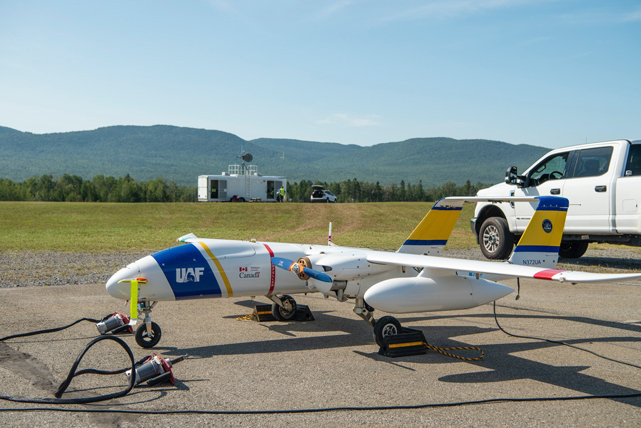From Transport Canada
Transport Canada is taking action through Canada’s $1.5 billion Oceans Protection Plan to protect and support in the recovery of the North Atlantic right whale. Not only has Transport Canada implemented speed restrictions in the Gulf of St. Lawrence to help prevent vessel strikes, we are also testing new drone technology to monitor this iconic species.
While some of our experts are developing new regulations for remotely piloted aircraft systems, known as drones, a team of Transport Canada employees in the Aircraft Services Directorate is testing drones in real-life conditions. It’s using remote pilot stations and flying drones beyond the pilot’s line-of-sight to find and track North Atlantic right whales in the Gulf of St. Lawrence.
Exploring the waters around Anticosti Island
In August 2018, experts from Transport Canada, Fisheries and Oceans Canada, Iqaluit-based Arctic UAV and the University of Alaska Fairbanks conducted a three-week drone mission in Gaspé, Quebec.
Using a Sea Hunter drone and flying as high as 4,000 feet, the team flew more than 5,500 kilometres (2,970 nautical miles) around Anticosti Island. They captured data and images with the drone’s onboard cameras and sensors.
Transport Canada experts supervised the trials and gave technical support on the ground. At the Michel-Pouliot Gaspé Airport, whale experts from Fisheries and Oceans Canada studied the data and images. They wanted to figure out if whales were present in the busy shipping lanes between Gaspé and Anticosti Island, whether in calm or rough seas or in clear or stormy skies.
Studying the data and images
We’re using these trial results to help us find new ways to find and track North Atlantic right whales and to better protect them from boats and fishing nets.
Fernando Mojica, Director of Remotely Piloted Aircraft Systems, is pleased with the outcome of this latest mission. He looks forward to working with partners on more missions in the future, particularly those that advance beyond visual line-of-sight capabilities in Canada:
“Transport Canada will continue to consider new opportunities to deploy innovative remotely piloted aircraft systems in a safe manner. We’re working with a wide range of stakeholders, including international organizations, standard-setting bodies, academia and industry, to advance drone work through research and development and trials.”
Looking to the future
This was Transport Canada’s second successful mission working with Fisheries and Oceans Canada. In March 2016, the department tested the use of drones for icebreaking operations off the coast of Newfoundland and Labrador. Having completed four missions, including two previous missions at the UAS Centre of Excellence in Alma, Quebec, the team is exploring new ways to use drones to one day detect oil spills, survey ice and marine habitats and monitor activity on the oceans.

